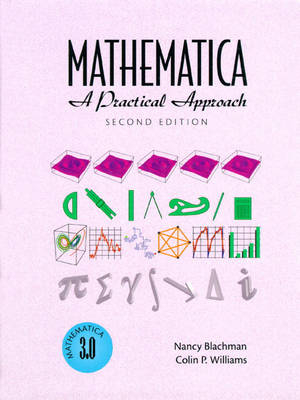
Mathematica
Prentice Hall (Verlag)
978-0-13-259201-7 (ISBN)
- Titel ist leider vergriffen;
keine Neuauflage - Artikel merken
For courses using Mathematica in departments of science, engineering, and mathematics.
The first edition of this title was THE best-selling Mathematica book of its time (other than the manual that's packaged with the software). It sold over 19,000 units since its publication in 1991. A new release of Mathematica has just hit the market, and this classic title has been revised and updated to accommodate the new release.
NANCY BLACHMAN is one of the nation's leading Mathematica trainers. In 1989, after working at Wolfram Research Inc., Ms. Blachman founded her own company, Variable Symbols, Inc., to provide both individual and group training in Mathematica to scientists and engineers. She teaches classes in Mathematica at Stanford University and is an invited speaker at conference and workshops on Mathematica. She has written four popular Mathematica books. She holds degrees in mathematics, operations research, and computer science from the University of Birmingham (UK), the University of California at Berkeley, and Stanford University. COLIN WILLIAMS has used Mathematica intensively since 1990 and has given numerous Mathematica tutorials to banks and engineering research labs. He recently co-wrote CalcLabs with Mathematica with Nancy Blachman, and Explorations in Quantum Computing with Scott Clearwater. Colin also teaches Mathematica at Stanford University. Colin holds a Ph.D. is artificial intelligence and advanced degrees in physics and atmospheric dynamics. He was a research scientist at Xerox PARC and a former research assistant to Prof. Stephen Hawking of Cambridge University.
(NOTE: Most chapters end with a Summary and Exercises).
I. USING MATHEMATICA INTERACTIVELY.
1. Getting Started with Mathematica.
Starting Mathematica. The In's and Out's of Mathematica. Using On-Line Help. Using Palettes to Enter Formulae. Notation Conventions. Saving Your Work and Quitting. A Quick Tour of Some Commands. Using the Standard Packages.
2. Numerical Capabilities.
Arithmetic Operations. Types of Numbers. Random Numbers. Numerical Precision. Integer Functions. Finding Roots of Equations. Numerical Integration. Numerical Differential Equations.
3. Symbolic Capabilities.
Manipulating and Simplifying Expressions. Trigonometry. Solving Equations. Differential Calculus. Series. Integral Calculus. Symbolic Sums, Products, and Limits. Symbolic Differential Equations.
4. Plotting Functions.
Two-Dimensional Plots. Changing the Appearance of Plots. Combining Plots. Parametric, Implicit and Polar Plots. Frames, Grids, Backgrounds and Ticks. Inserting Annotations to a Plot. Three Dimensional Plots. Contour Plots and Density Plots.
5. Visualizing Data.
Plotting Data in Two Dimensions. Error Plots. Log Plots. Bar Charts and Pie Charts. Two-Dimensional Fields.
6. Data Manipulation and Analysis.
Lists and Nested Lists As Data Structures. Re-ordering and Partitioning Data. Inserting, Replacing, and Deleting Elements. Selecting Subsets of the Data. Counting and Binning Elements. Mapping Functions over Data. Statistical Analyses. Curve Fitting. Data Interpolation.
7. Getting Around with Notebooks.
Initialization Cells. Default Output Form for Formulae. Interacting with Outputs. Cell Brackets. Menus in Notebooks.
II. PROGRAMMING.
8. Writing Your Own Programs.
A Simple Program. Multi-Line Programs. Localizing Variables. Programs with Multiple Calling Patterns. Logical Operators and Tests. Conditional Execution. Adding Usage Messages. Adding Error Messages.
9. Rule-Based Programming.
Local Rewrite Rules. Rules Don't Always Work As Expected. Controlling How Rules Are Applied. Types of Patterns. Uses of Patterns.
10. Functional Programming.
Nesting Function Calls. Recursive Functions. Anonymous (Pure) Functions. Variants of Map. Apply. Select. Functional Alternatives to Loops.
11. Procedural Programming.
Arrays. Counter Variables. Loops and Iteration. Conditionals.
12. Graphics, Animation and Sound.
Two-Dimensional Graphics Primitives. Setting Styles for Graphics Primitives. Three-Dimensional Graphics Primitives. Creating Animations. Creating Sounds.
13. Writing Interactive Programs.
Asking Questions and Getting Replies. Strings. Checking a User's Answer. Managing User Interaction.
14. Notation, Buttons, and Palettes.
Special Notation. Defining Buttons. Creating Palettes.
III. Building Larger Applications.
15. Speeding Up Your Programs.
Timing Your Programs. Avoid Exact Arithmetic. Avoid Evaluating Data Structures. Avoid the Procedural Style. Compile Numerical Functions.
16. Writing Your Own Packages.
Why Write a Package? Contexts. Package Style. Loading Packages. Accidental Shadowing.
17. Working with Files.
Telling Mathematica where to Look. Importing Data from Files. Exporting Data. Low-Level File Interaction. Exporting Special Formats. Exporting Graphics. Exporting HTML Files. Exporting Function Definitions. Searching the Contents of a File.
18. Example Applications.
Monte Carlo Simulations. Cryptography.
Appendix A: Answers to Odd-Numbered Exercises.
Appendix B: Suggestions for Further Reading.
Appendix C: Index.
| Erscheint lt. Verlag | 14.1.1999 |
|---|---|
| Verlagsort | Upper Saddle River |
| Sprache | englisch |
| Themenwelt | Informatik ► Office Programme ► Outlook |
| Mathematik / Informatik ► Mathematik ► Finanz- / Wirtschaftsmathematik | |
| ISBN-10 | 0-13-259201-0 / 0132592010 |
| ISBN-13 | 978-0-13-259201-7 / 9780132592017 |
| Zustand | Neuware |
| Informationen gemäß Produktsicherheitsverordnung (GPSR) | |
| Haben Sie eine Frage zum Produkt? |
aus dem Bereich


